
Riesling is a white grape variety that originated in the Rhine region. Riesling is an aromatic grape variety displaying flowery, almost perfumed, aromas as well as high acidity. It is used to make dry, semi-sweet, sweet, and sparkling white wines. Riesling wines are usually varietally pure and are seldom oaked. As of 2004, Riesling was estimated to be the world's 20th most grown variety at 48,700 hectares, but in terms of importance for quality wines, it is usually included in the "top three" white wine varieties together with Chardonnay and Sauvignon blanc. Riesling is a variety that is highly "terroir-expressive", meaning that the character of Riesling wines is greatly influenced by the wine's place of origin.

Pinot blanc is a white wine grape. It is a point genetic mutation of Pinot noir. Pinot noir is genetically unstable and will occasionally experience a point mutation in which a vine bears all black fruit except for one cane which produces white fruit.
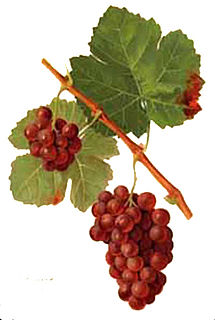
Gewürztraminer is an aromatic wine grape variety, used in white wines, and performs best in cooler climates. In English, it is sometimes referred to colloquially as Gewürz, and in English and French it is written Gewurztraminer. Gewürztraminer is a variety with a pink to red skin colour, which makes it a "white wine grape" as opposed to the blue to black-skinned varieties commonly referred to as "red wine grapes". The variety has high natural sugar and the wines are white and usually off-dry, with a flamboyant bouquet of lychees. Indeed, Gewürztraminer and lychees share the same aroma compounds. Dry Gewürztraminers may also have aromas of roses, passion fruit and floral notes. It is not uncommon to notice some spritz.

The Muscat family of grapes includes over 200 grape varieties belonging to the Vitis vinifera species that have been used in wine production and as raisin and table grapes around the globe for many centuries. Their colors range from white, to yellow, to pink to near black. Muscat grapes and wines almost always have a pronounced sweet floral aroma. The breadth and number of varieties of Muscat suggest that it is perhaps the oldest domesticated grape variety, and there are theories that most families within the Vitis vinifera grape variety are descended from the Muscat variety.

Macabeo, also called Viura or Macabeu, is a white variety of wine grape.

Sylvaner or Silvaner is a variety of white wine grape grown primarily in Alsace and Germany, where its official name is Grüner Silvaner. While the Alsatian versions have primarily been considered simpler wines, it was included among the varieties that can be used to produce Alsace Grand Cru wine in 2006, together with the four 'noble grapes' of Alsace, although only in one vineyard, Zotzenberg.

Gouais blanc or Weißer Heunisch is a white grape variety that is seldom grown today but is important as the ancestor of many traditional French and German grape varieties. The name Gouais derives from the old French adjective ‘gou’, a term of derision befitting its traditional status as the grape of the peasants. Likewise, the German name Weißer Heunisch labels it as one of the lesser "Hunnic" grapes.
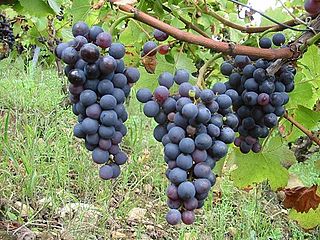
Poulsard is a red French wine grape variety from the Jura wine region. The name Ploussard is used mainly around the town of Pupillin but can appear on wine labels throughout Jura as an authorized synonyms. While technically a dark-skinned noir grape, the skins of Poulsard are very thin with low amounts of color -phenols and produces very pale colored red wines, even with extended maceration and can be used to produce white wines. Because of this, Poulsard is often blended with other red-skin varieties or used to produce lightly colored rosé wines. Additionally the grape is used to make blanc de noir white wines and sparkling cremants.
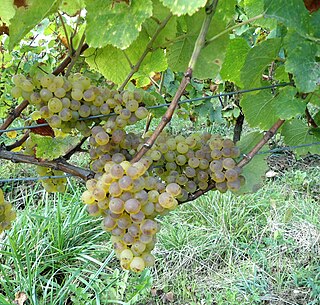
Savagnin or Savagnin blanc is a variety of white wine grape with green-skinned berries. It is mostly grown in the Jura region of France, where it is made into Savagnin wine or the famous vin jaune and vin de paille.
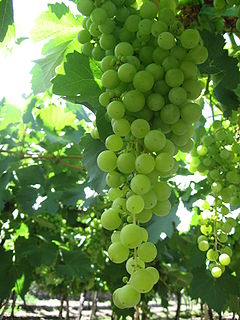
Torrontés is a white grape variety, mostly produced and known in Argentine wine, producing fresh, aromatic wines with moderate acidity, smooth texture and mouthfeel as well as distinctive peach and apricot aromas on the nose. Three Torrontés varieties exist in Argentina: Torrontés Riojano, the most common, Torrontés Sanjuanino, and Torrontés Mendocino. It is primarily Torrontés Riojano that has received attention for the quality of its wines, and is the variety used for most Argentine wines simply labeled Torrontés.
Klevner or Clevner is a synonym for various grape varieties and wines, and is primarily used in German-speaking wine regions. The word derives from the Swiss version of the name of the Northern Italian town Chiavenna, Kleven, situated at the north end of Lake Como. Swiss mercenaries brought grapevines from that region back home across the Alps at the beginning of the 16th Century.

Piquepoul, Picpoul, or Picapoll is a variety of wine grape grown primarily in the Rhone Valley and Languedoc regions of France as well as Catalonia, Spain. It exists both in dark-skinned and light-skinned versions, as well as a very little grown Piquepoul gris. Piquepoul blanc is the most common of the Piquepouls, with 1,000 hectares cultivated in France in 2000, and an increasing trend.

Aramon or Aramon noir is a variety of red wine grape grown primarily in Languedoc-Roussillon in southern France. Between the late 19th century and the 1960s, it was France's most grown grape variety, but plantings of Aramon have been in continuous decline since the mid-20th century. Aramon has also been grown in Algeria, Argentina and Chile but nowhere else did it ever reach the popularity it used to have in the south of France.
Petit Meslier is a rare white wine grape that is a minor component of some Champagne blends. It is valued for its ability to retain acidity even in hot vintages. In the very rare cases where it is not blended, it makes crisp wines tasting of apples. The Traminer family of grapes can be difficult to grow, with poor disease resistance and low yields.

Picardan or Picardan blanc is a white wine grape which is one of 13 permitted blending grapes within the Châteauneuf-du-Pape AOC in Rhône wine region in France, although very little planted. The Vitis International Variety Catalogue previously listed Oeillade blanche as the primary name of the variety, but now identifies Araignan as the primary name. However, since the variety is practically unknown for any other use than the Châteauneuf-du-Pape blend, it most commonly goes under the name used for it in that appellation.

Klevener de Heiligenstein, also known in English by its German name, Heiligensteiner Klevener, is a designation used on Alsace wine made from pink-skinned Savagnin rose grapes, a variety in the Traminer family, but which is less aromatic than Gewürztraminer, which is widely planted in Alsace. The designation may be allowed for selected vineyards in the villages Bourgheim, Gertwiller, Goxwiller, Heiligenstein and Obernai but, under current appellation rules, the designation may be used until 2021 for specified existing vineyards outside the designation area. Since Savagnin rose is not a permitted variety for other Alsace wines, its replanting outside this area is not allowed.
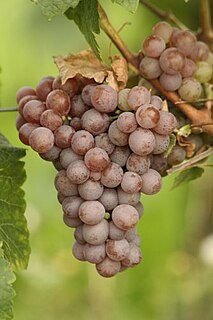
Musqué is a French term applied to certain varieties or clones of grapes used for making wine. The term means both perfumed ("musky") and Muscat-like, and indicates that the variety or clone is highly aromatic. The term musqué is usually suffixed to the name of certain grape varieties to indicate a clone with musqué properties, e.g. "Chardonnay musqué" or "Sauvignon blanc musqué". Such clones have arisen through mutation of a regular ("non-musqué") clone of the variety, and such mutations have been recorded for several different grape varieties.
Cereza is a white Argentine wine grape variety. Like Gewürztraminer and Pinot gris, Cereza is a pink skinned variety. It is a crossing of Muscat of Alexandria and Listan negro.
Terret gris is a white French wine grape variety planted primarily in the Languedoc wine region. It is a mutation of the ancient Vitis vinifera vine Terret. Appellation d'origine contrôlée (AOC) regulations allow the grape to be used in white wines from the Corbières, Coteaux du Languedoc and Minervois AOCs as well as some vin de pays. The vine has a very long history in the region and is capable of producing full bodied wines with crisp acidity.

Incrocio Manzoni or Manzoni grapes is a family of grape varieties named after Professor Luigi Manzoni (1888-1968) of Italy's oldest school of oenology located in Conegliano, in the Veneto region. Manzoni created the new grape varieties by selecting, crossing and grafting vines from various vineyards during the 1920s and 1930s. The family includes both white and red grape varieties. Although most Manzonis are grown in northeastern Italy, they are mainly grown in the Piave area of Province of Treviso and are only now starting to be sold commercially in Europe and the United States.
















